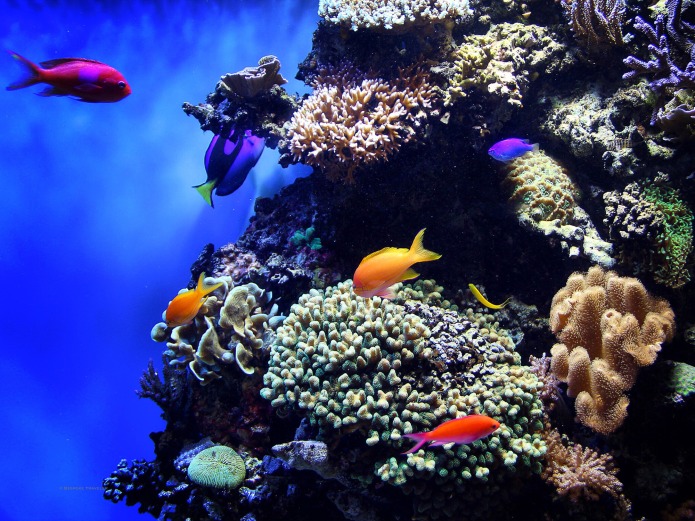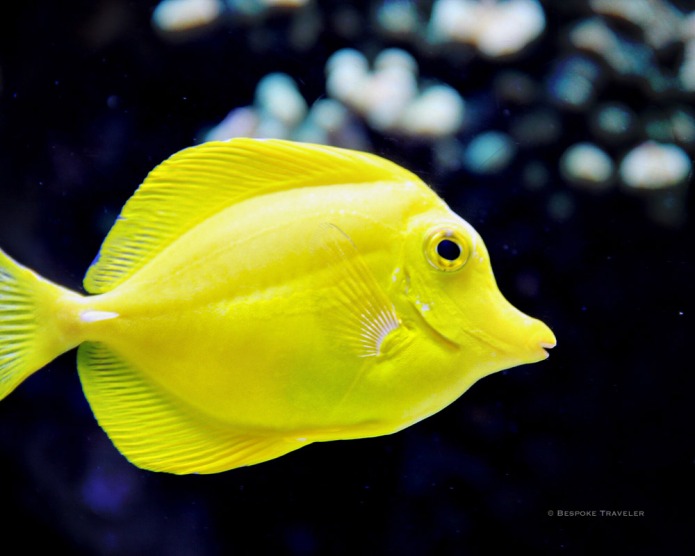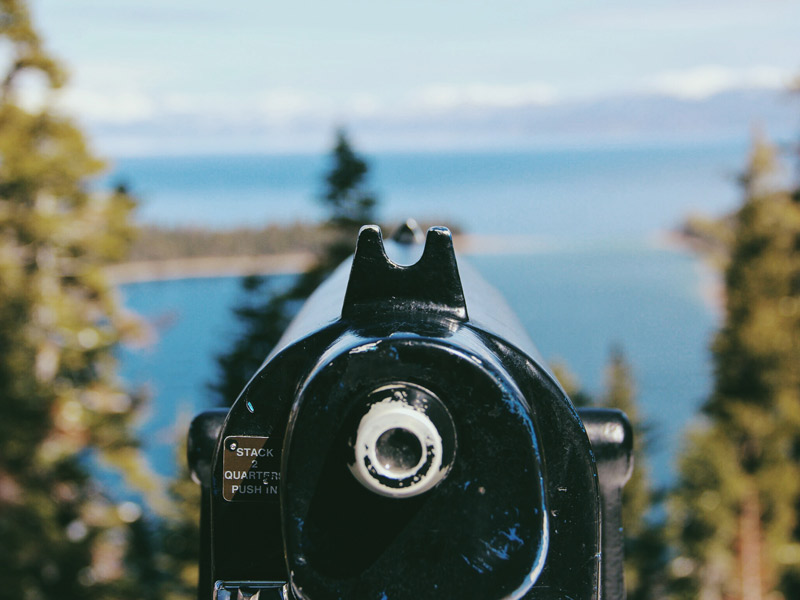 I like watching animals, four-legged, finned, or human. As a writer it is integral to my work that I observe the behavior of others in order to grasp what motivates them. It is best to do this in the creature’s natural environment: on the veldt, under the waves, or at a city café. I have been fortunate to have this opportunity, but I am not alone in my penchant for gawking. Judging from the crowd at Monterey Bay Aquarium in California, fauna viewing is not an exclusive pastime of maladjusted writers. We seem to gather instinctive joy out of ogling other beings, mesmerized by their quotidian affairs, eager to glean their intimate habits. The stranger the beast to us, the more fascinated our interest.
I like watching animals, four-legged, finned, or human. As a writer it is integral to my work that I observe the behavior of others in order to grasp what motivates them. It is best to do this in the creature’s natural environment: on the veldt, under the waves, or at a city café. I have been fortunate to have this opportunity, but I am not alone in my penchant for gawking. Judging from the crowd at Monterey Bay Aquarium in California, fauna viewing is not an exclusive pastime of maladjusted writers. We seem to gather instinctive joy out of ogling other beings, mesmerized by their quotidian affairs, eager to glean their intimate habits. The stranger the beast to us, the more fascinated our interest.
 The obsession begins at a tender age. There is the stuffed critter that accompanies our bedtimes; the books in which we learn our mother tongue through the help of illustrated wildlife; the movies about lost pets or talking bears, ducks, foxes, and fish on an adventure. Eventually, we may visit our first lion within the confines of a zoo or meet a shark inside a tank. That physical encounter is significant and will become more so for future generations as habitats diminish. The faces of the children around me hold the same expression, wonder. They inspect the circling bluefins, the undulating jellies, the placid turtles. In groups of varying attention they listen to fun facts about the mating of puffins, touch the starfish, giggle at penguin antics. For most this will be the only time they will get to experience our marine wilderness.
The obsession begins at a tender age. There is the stuffed critter that accompanies our bedtimes; the books in which we learn our mother tongue through the help of illustrated wildlife; the movies about lost pets or talking bears, ducks, foxes, and fish on an adventure. Eventually, we may visit our first lion within the confines of a zoo or meet a shark inside a tank. That physical encounter is significant and will become more so for future generations as habitats diminish. The faces of the children around me hold the same expression, wonder. They inspect the circling bluefins, the undulating jellies, the placid turtles. In groups of varying attention they listen to fun facts about the mating of puffins, touch the starfish, giggle at penguin antics. For most this will be the only time they will get to experience our marine wilderness.
 I remember the emaciated tiger I beheld at my first menagerie, pacing its empty double-barred cage — within its miserable face were eyes that contained other worlds. Decades later, as an adult I confronted that uncanny look in its unfettered complexity at Ranthambore National Park. Only then did I comprehend a little of the appeal behind our scrutiny of other species. Stare into a snake’s slits, a cheetah’s pupils, a dolphin’s aperture and they reveal a peculiar familiarity. They are of us yet separate; sharing common traits of physiology while existing as complete realms unto themselves. We examine them, collect data about them, survey them behind glass. Still they mystify us by a sideways glance, a long probe, an abrupt confrontation that puts us in our place. Baffled by our need of them and our power over their fate, we grapple with how to subsist with them. We enslave them, idolize them, make sport of them, gather them in containers, and anthropomorphize them, always measuring them against our distorted standards. Though we share one planet, it seems our universes can only collide.
I remember the emaciated tiger I beheld at my first menagerie, pacing its empty double-barred cage — within its miserable face were eyes that contained other worlds. Decades later, as an adult I confronted that uncanny look in its unfettered complexity at Ranthambore National Park. Only then did I comprehend a little of the appeal behind our scrutiny of other species. Stare into a snake’s slits, a cheetah’s pupils, a dolphin’s aperture and they reveal a peculiar familiarity. They are of us yet separate; sharing common traits of physiology while existing as complete realms unto themselves. We examine them, collect data about them, survey them behind glass. Still they mystify us by a sideways glance, a long probe, an abrupt confrontation that puts us in our place. Baffled by our need of them and our power over their fate, we grapple with how to subsist with them. We enslave them, idolize them, make sport of them, gather them in containers, and anthropomorphize them, always measuring them against our distorted standards. Though we share one planet, it seems our universes can only collide.
 When we gaze into an animal’s life, what is it we hope to catch? I find tranquility while contemplating crimson-gold sea nettles flow past me through an electric blue background. A black-necked stilt wading through planted grass fills me with nostalgia. As the anchovy school spiral around the kelp forest exhibit, I swim with them in my imagination. For a brief moment I partake in their grazing ritual, mouth agape, a teeming underwater fabric coursing through me. It is hallucinatory and like all such excursions comes with a price, but not one I will pay. I can walk out into the coastal California sunshine. Free to wander away, I can leave the captive creatures of the deep revolving around their artificial domains. I can relegate the starfish, anemone, otter, and manta to mere circus attractions.
When we gaze into an animal’s life, what is it we hope to catch? I find tranquility while contemplating crimson-gold sea nettles flow past me through an electric blue background. A black-necked stilt wading through planted grass fills me with nostalgia. As the anchovy school spiral around the kelp forest exhibit, I swim with them in my imagination. For a brief moment I partake in their grazing ritual, mouth agape, a teeming underwater fabric coursing through me. It is hallucinatory and like all such excursions comes with a price, but not one I will pay. I can walk out into the coastal California sunshine. Free to wander away, I can leave the captive creatures of the deep revolving around their artificial domains. I can relegate the starfish, anemone, otter, and manta to mere circus attractions.
 As we struggle with our responsibilities towards them, what role will places like the Monterey Bay Aquarium play in this complicated puzzle? Will it be too late for the field trippers being taught about the dangers of contamination to devise holistic solutions to protect the ocean’s depleting diversity? Which of the youngsters purchasing plush whales as souvenirs will regard the kingdom of non-humans as valuable unto itself? In the midst of raging debate over the morality of zoos and vivariums, the responsibility of stewardship belongs not just to these institutions but also each of its patrons.
As we struggle with our responsibilities towards them, what role will places like the Monterey Bay Aquarium play in this complicated puzzle? Will it be too late for the field trippers being taught about the dangers of contamination to devise holistic solutions to protect the ocean’s depleting diversity? Which of the youngsters purchasing plush whales as souvenirs will regard the kingdom of non-humans as valuable unto itself? In the midst of raging debate over the morality of zoos and vivariums, the responsibility of stewardship belongs not just to these institutions but also each of its patrons.
 A few steps away, under the cobalt Pacific depths, untamed cousins of all the aquarium dwellers perform their dance. If I am to do these fauna justice I have to become a participant. I have to further decrease my consumption and commit to my recycling habits. I have to learn about aquatic ecosystems. I have to support the unbiased scientific research that carries on behind the scenes. I have to do more than visit wildlife reserves and national parks to gaze at the inhabitants. I must be a partner to the beasts who provide me with so many life lessons. Then, I can look them in the eye.
A few steps away, under the cobalt Pacific depths, untamed cousins of all the aquarium dwellers perform their dance. If I am to do these fauna justice I have to become a participant. I have to further decrease my consumption and commit to my recycling habits. I have to learn about aquatic ecosystems. I have to support the unbiased scientific research that carries on behind the scenes. I have to do more than visit wildlife reserves and national parks to gaze at the inhabitants. I must be a partner to the beasts who provide me with so many life lessons. Then, I can look them in the eye.
TRAVEL NOTE:
Plastic pollution is a major threat to marine wildlife and the Monterey Bay Aquarium is working to be part of the solution by avoiding single-use plastic. Visitors are encouraged to bring their own reusable bags and, when purchasing gifts, choose items that are environmentally responsible and made by local artisans.
Have a favorite children’s book about animals? Have a favorite underwater creäture you have seen? Share in the comments below.
Discover more from Bespoke Traveler
Subscribe to get the latest posts sent to your email.





These are amazing shots! Mesmerizing. Great topic as well. We were happy to learn recently that California banned single use bags in all the grocery stores, and even more interesting to me, that was already in effect the first day I went shopping after hearing the news!
I learned while there that the Monterey Bay Aquarium was one of the major supporters of the state-wide ban against single-use plastic! While traveling through this part of California, I am discovering so much about how locals, non-profits, and businesses are advocating for the environment in different ways.
What great pictures! I’ve been there as well and it made me love jellyfish forever. 🙂
😀 They are so mesmerizing to watch. Thanks for your kind words!
Seems that I’ve just read a beautiful story with amazing illustration. Nice post! 🙂
Thank you.
Such beautiful photography and a well-written story. Seems that we are failing at our stewardship of this beautiful planet and all of God’s creatures. I’m thankful for those people who are taking action to rectify the issues.
Thank you. I am inspired to live and travel more sustainably through their efforts.
I love walking around those huge tanks looking at all the various kinds of fish. It’s like scuba diving in comfort. Anyway, I enjoyed the post. I hope visits to aquariums inspire other visitors to think more seriously about their environment too.
Thank you. I hope so too.
Amazing information & stunning photos of the world’s aquariums.
Beneath the water is strange territory for me, AG. I can feel desolate at a lion in a zoo, but fish never touch my feelings. It’s an incredible but totally alien world. But not one that I feel we should litter with plastics.
😆 It is difficult to feel a kinship with jellyfish. They seem so unlike us. Unfortunately it is the larger marine animals (whales, dolphins) and birds who are suffering the most from excess plastic littering.
An excellent and thoughtful post. This is so well written and brings up the important topics of humanity to animals, preserving wildlife and discussions about why and how we use animals and marine life for our own human entertainment. Globally wildlife is threatened everywhere, as man encroaches their space and natural habitat.
Peta
Thank you Peta. There are no easy answers to preserving our wildlife and every solution is going to restrict the lives and movements of someone, animal or human. But I do believe that it is up to each of us individually to decide what we want for the future and how we are going to act to make that happen. Thanks so much for sharing your thoughts with me.
Wow–both your words and your photography are compelling and rich! I just discovered a writer named Eva Saulitis, who writes about her engagement with orcas in the Alaskan sea after the Exxon Valdez spill–your writing reminds me of hers. Thanks for a lovely, lovely post…
I am looking forward to reading some of Saulitis’ work. Thank you so much for the recommendation.
It’s always risky to recommend someone else’s work–I know different voices speak differently to all of us. I hope this is one that speaks to you!
I have that fear of recommending things too…especially things I hold dear to my heart. Saulitis’ eloquent essay “Wild Darkness” in Orion Magazine was piercing, addressing a lot of what I have been thinking about lately. I was sad to hear of her passing, but I am excited to read more of her incredible works and so humbled to be compared to her by you. I am deeply grateful that you took the risk and shared this with me.
I discovered her in the Sun, and then found the Orion essay on line…which led me to order her first book…and now I can’t wait to read more…
Wow, such a wonderful article, and a well-pointed signal for animals’ future! I read these days about a dying whale who was discovered off the coast of western Norway with more than 30 plastic bags in its stomach… 😦 We have a so beautiful planet and we MUST share it with all animal species, and our children MUST know about them not only from the books! Best wishes, Catalin
Most of the marine animals found these days have massive amounts of ingested plastic. A global culture of quickly made throw-away goods is depleting resources and making the livelihoods of those who work sustainably very difficult. I think it is each of our responsibility to change that if we want future generations to enjoy the things we are taking for granted: clean air, fresh water, and green spaces. Thank you so much for sharing your thoughts about this subject.
I LOOOOOVE Aquariums!!! Great pictures and amazing post!
🙂 The Monterey Bay Aquarium is dedicated to doing more than showcasing wild marine animals behind glass and I had a wonderful learning experience there.
Beautiful photos. I’ve always wanted to visit the Monterey Aquarium and your post has further inspired me. I agree with your assessment – we’re looking for ourselves or something in the fish or animals that we can relate to. But you’re right, children (and adults) need to take more away from the experience than a stuffed animal. The information is out there with regard to ecology and what individuals can do personally. The question is whether they’ll head the advice and if it will be in time to preserve these magnificent creatures.
I loved that the Monterey Bay Aquarium is focused on a ton of conservation efforts from how to breed aquarium creatures so that there won’t be a market for catching them in the wild to working with local fishermen for a sustainable seafood industry. The complex solutions they are working on are not easily digestible or swiftly implemented and many won’t show quick results, but they are there. Now it is up to each of us to decide what we want for the future and what we will do personally to change it. Thanks so much for your thoughtful comment.
Beautiful pictures and lovely perspective! The first time when I visited such a big Aquarium I was amazed at the sea life it captures before us, so near!I love watching jelly fish, they are most graceful! These finned creatures appear to be more wonderful than the animals in zoos.
Jellyfish are incredibly beautiful to watch and are the oldest multi-organ animals on our planet. Their population explosion in recent years, however, is causing concerns about ecosystem changes. Thanks for sharing your aquarium experience with me!
Fabulous captures!
Thank you!